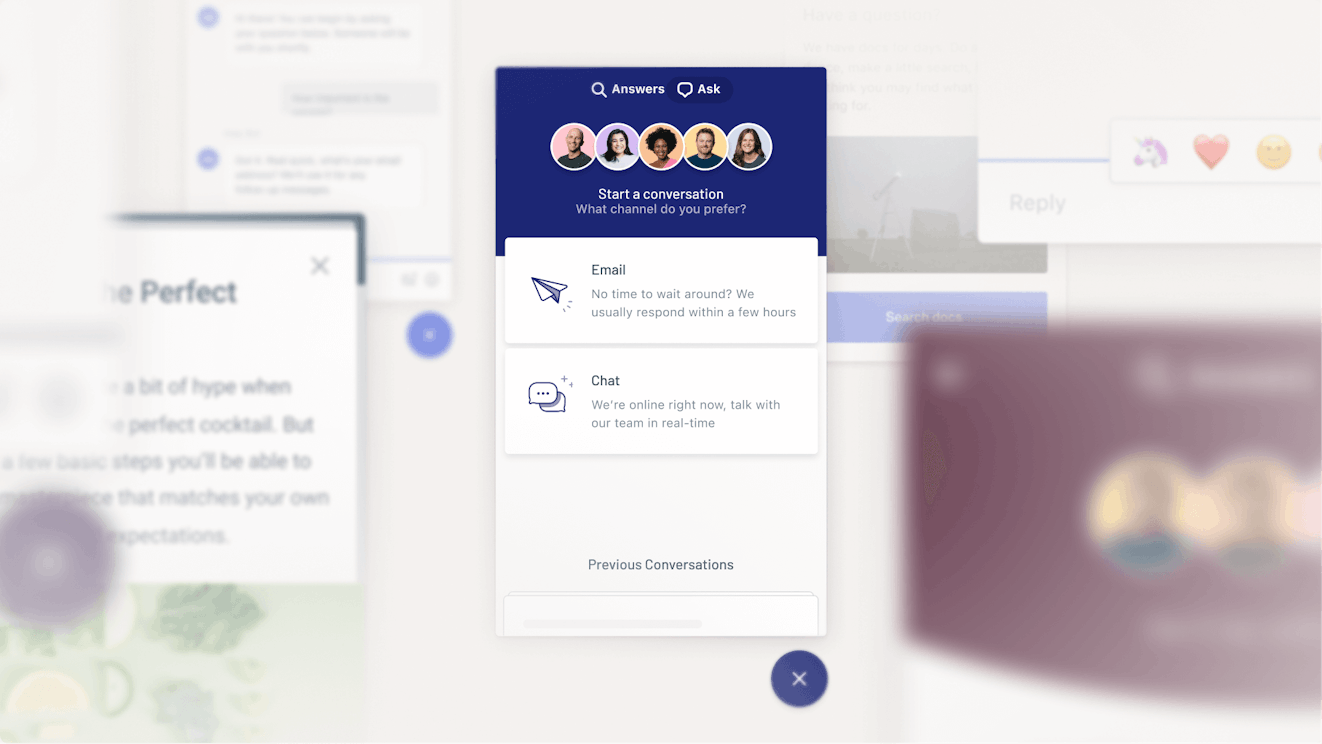Customer service live chat combines real-time conversation with the ability to share links, collect information, and save a full transcript for later reference. It's the ideal online service tool for a customer who needs immediate help.
Getting started with live chat is simple, but making it a sustainable, effective part of your customer service strategy takes careful thought and effort. We've compiled these live chat best practices and tips to make it easier.
What is live chat?
Live chat is a support channel that gives customers and support agents a way to have real-time, back-and-forth, test-based conversations. Using live chat software embedded on a company’s website, customers can send their questions to a person who can quickly reply to them in the same small window.

8 live chat best practices for great customer service
Delivering consistently great customer service through live chat is not easy, but it doesn’t have to be complicated. We’ve spoken to customer service folks about their experiences and collected the following best practices.
1. Keep the incoming volume manageable
Your customers look to chat for quick, accessible interaction with your team. If your chat team struggles to keep up, the customer experience will suffer. Use reporting to keep an eye on the overall volume and response time, and take action if needed.
Consider offering chat only during certain time windows or to certain customer groups to control volume. Also, consider scheduling some agents to be on standby. While they can spend most of the day working in the email queue or on other projects, they can jump over to live chat as needed when volumes exceed what the dedicated chat agents can handle.
2. Limit the number of chats agents can work on at once
A typical support agent can handle 2-5 concurrent chats without losing service quality, but that depends heavily on the type of questions they are answering and the levels of experience of both customer and agent. Look for live chat software that lets you set a maximum chat number so that no one team member is overwhelmed with chat requests.
3. Choose the right places to offer chat support
You don’t have to offer chat everywhere to every customer. Consider carefully where the unique benefits of live chat will make the biggest impact.
Perhaps it will be for your sales team for talking to incoming prospects. Or perhaps it could be offered to your VIP customers as an additional benefit.
Many live chat tools make it easy to display your chat on specific pages and locations, whether that’s on your main website, inside an application, or attached to your contact page.
4. Meet the expectations of live chat
To customers, “live chat” implies an almost instant response, so a delayed reply to a chat is a much poorer experience than a slow email reply. Set your live chat hours to an achievable level, and make those hours clearly visible.
5. Avoid scheduling overly long chat shifts
Long, challenging shifts on chat without flexibility to switch up tasks is a surefire way to wear down your team. Being on chat for eight hours straight is very demanding. You’re always “on” and multitasking between customer conversations. Flexibility can really help keep agents fresh, even when the work becomes difficult.
6. Set guidelines for handling ongoing chats during shift changes
Negotiating lunch and bathroom breaks when stuck on an epic chat is a common concern for agents. Or even tougher: If a customer still needs help but the shift is ending, how does an agent handle it?
Set guidelines for how early agents turn off their availability before the end of their shift to prevent them from getting trapped in a never-ending queue of chats. Or alternatively, encourage agents to warmly transfer chats to someone else who is available, either by leaving notes in the chat or pinging details in Slack.
Try overlapping teammates so the person reaching the end of the day can sign off chat a half-hour beforehand. Or schedule their online hours such that their day ends an hour after your live chat hours end, reducing the impact on their personal time.
7. Train your team on how to deliver live chat support
Chat is a different medium than email or phone, and your team will need to apply their skills differently. For example:
How will you greet customers in chats?
Can you break down longer and more detailed replies into separate pieces? This lets you make sure the customer is understanding everything as you go.
How and when will you transition a chat into an email or phone call? Sometimes chat is not a good option for resolving complex or technical issues.
Consider sending your team out onto the web and have them start a few chats with different businesses. They’ll soon learn what makes for a great chat experience and what approaches are best avoided.
8. Watch, learn, and tweak
How many simultaneous chats can your team handle at high quality? What do customer satisfaction ratings look like for your chat customers, and how does that compare to your other support channels?
Talk to your team and use all the available reports to figure out what’s working well and what might benefit from a tweak here or there.
For agents, collect feedback periodically to check if they’re still happy with their chat schedules. Are they burning out from too much chat? Do they feel overwhelmed with the volume? Or are they bored with babysitting a quiet queue?
Change it up when it’s not working to keep employee satisfaction high so they can do their best work.
For customers, keep an eye on chat wait times and the number of unanswered chats. If you see either number increasing, it might be worth considering how you can expand your customer support availability.
A sudden increase in volume might be temporary and not require drastic changes in strategy — just more flexibility. A consistent trend upwards suggests that a plan is needed to increase your capacity.
Balancing chat coverage and agent happiness requires a constant reevaluation of what’s working and what needs improvement. As you become better acquainted with your company’s incoming chat volume, you’ll become better at meeting the needs of your customers.
Live chat tips for customer support agents
Delivering high-quality live chat support requires, as Liam Neeson might say, “a very particular set of skills.” Build on the email support experience you already have with these six live chat tips.
Manage the conversation
Email support is like old-school letter writing with really fast mail carriers, but chat support works more like a live conversation. People can talk over each other, or one person can really dominate the discussion. So guiding a live chat to a successful end means keeping control of the conversation.
Follow these tips to keep live chat on track:
Get everyone on the same page. Make sure that you and your customers are clear about what they need and what you need from them.
Set accurate expectations. If you're going to need to step away from the chat, tell customers what's happening so they don't freak out and think you've disappeared.
Build firm boundaries. Don't be afraid to ask customers to focus on one thing at a time so that you can best help them. And be sure to have some prepared responses for cases of abuse or inappropriate behaviors.
Know when to transfer channels. Some questions are just best handled by email or on the phone, so think about what those might be for your team. And when they come up, make that transition as graceful as you can.
"You want to make sure you’re in control. Rather than letting the customer inundate you with questions or information, tell them what you need and what they should do."
Diana Potter - Customer Support Team Lead at Qwilr
Increase your speed
In email support, sending a response within 15 minutes of receiving a request would be amazing. Even a 45-minute response might be amazing most of the time because your customers mostly aren't hanging out hitting refresh on Gmail. But if you were in a face-to-face conversation and the other person suddenly stopped talking, well, you would be rightly concerned. The same goes for support chats. Responsiveness matters more in live chat support.
Follow these tips to speed up your support:
Improve your typing speed. Mitchell Brown, Customer Experience Rep at Tommy John, says, "Typing speed is definitely an important part of offering chat support, especially when you are managing three or four conversations. You can be a little more brief with replies to get the resolution needed on both sides."
Use saved replies and text expansion tools. These tools quickly insert information for you so you don't have to type the same things over and over.
Provide estimates for delays. Breetel Graves, Support Specialist at Campaign Monitor, says, "When you don’t know something or have to troubleshoot, provide estimates for how long it might take, and don’t be afraid to suggest transferring to a different medium (email/phone) if chat is not the best for their issue."
Write concisely
In chat, conversations can scroll past quickly, and they're often squeezed into a pretty small frame surrounded by all sorts of distracting things. So it's vital that you get to the point quickly and clearly if you want to be understood.
To get better at writing concisely, follow these tips:
Build up your knowledge. It's when you try to teach something that you discover if you really understand it. You need to know what information is the most important to get across and what could be safely left out.
Ruthlessly cut the fluff. Waffling explanations and rare edge cases can get in the way of understanding. Get to the core answer quickly.
Always use simple language. Avoid using internal jargon or quirky marketing terms. Stick to the words that your customers use, and be sensitive to their different cultures and different language backgrounds.
Be specific in your directions. Instead of saying "jump over to the user preferences area," say, "click account, then click billing." That precise word choice is going to avoid a whole lot of customer confusion.
Break down long answers
In email support, you get really good at taking your customers big block of questions and then comprehensively addressing them all in the hope of resolving it for them with one reply. And that's because it might be hours before they see it.
But with chat, you have an opportunity for real-time feedback. Just like you wouldn't give a baby a whole bowl of food all at once — you would give them a little spoonful and see if they're going to spit it out — similarly, you can break down your support answers into small chunks.
Give customers one idea or action at a time, and then let them respond. You can see if they're getting it or if you need to try and explain it differently.
"Chat messages can tend to be less clear, so practice the ability to read between the lines and figure out the real issue/question without requiring so much back and forth."
Jarratt Isted - CoFounder at HelpDocs
Take time to teach
Sometimes, your customer just needs your help to take an action that they can't take. But other times you've got an opportunity to help them understand your service or your product more deeply — or to teach them how to solve their own problem.
In these cases, you should:
Promote your self-service help documents. Let them know where they are and how they can search them and find them.
Encourage exploration. Point them to product features or items that they may not have seen yet.
Share tips or tricks or setups that are particular to their usage. You want to help your customers kick butt instead of having to drag a butt over for you to kick it for them.
Close the conversation elegantly
Endings can be hard. If you don't close them out well, conversations can drag on like the last bit of The Lord of the Rings movie. To close a live chat conversation elegantly:
Check for any other issues. Make sure that they've got what they need. Ask: "Did you have any other questions for us?"
Leave customers with clear directions. Do they need to take some action? Do they need to get back to you with other documents?
Give them genuine thanks. Thank them for their time and their business.
Add some personality. You've already been friendly, now you can make a connection. Share something fun, and then finish it off.
Create a clear end point. Don't just ghost on them. Let them know that you're leaving and that you'll be there if they need help again in the future.
The right tool will help you rock chat support
Adding a whole new channel can be challenging for a support team, but you’re opening up real-time communication with your customers. That is an incredible opportunity to give them a better experience and to have conversations that are less likely to happen over email.
Help Scout's live chat tool, Beacon, was built to enable those conversations in a way that sets clear service expectations and helps direct customers to self-service channels where it makes sense.
If you’ve been interested in offering live chat to your customers but scared of the impact it may have on your team and your existing quality of service, Beacon could be a really great option to consider.
Chat support can be fast-paced — and it can be challenging at times — but the research shows customers love it. And when it's done well, it can deliver great business value.








